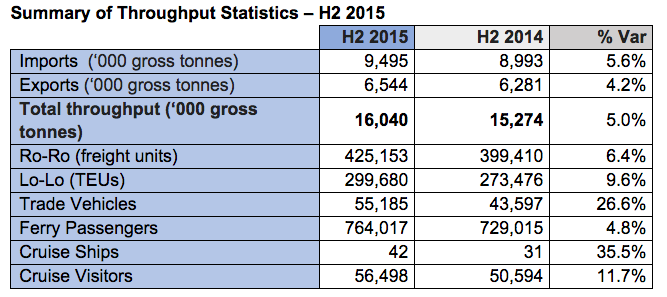Dublin Port Company today published trade statistics for the first six months of the year. The figures show a notable spread in growth across both import and export trade at Ireland's premier port with overall cargo volumes rising 5.0% on the same period last year. Dublin Port is now firmly on track for a record trading year in 2015.
Total throughput (imports and exports) for the year to date was 16 million gross tonnes, an increase of 5.0% on the 15.3 million tonnes handled in the first six months last year. Imports performed strongly at 9.5 million gross tonnes while exports strengthened, reaching 6.5 million gross tonnes, up 5.6% and 4.2% respectively on the same six month trading period in 2014.
The figures reflect continued growth in the domestic economy, driven by the increased movement of unitised goods (containers and trailers). The spike in petroleum imports reported in Q1 shows no sign of abating, rising 6.3% on the year to date as more vehicles take to our roads.
Unitised trade grew strongly across both Ro-Ro and Lo-Lo modes. When compared to the same period last year, Ro-Ro trailers moved ahead by 6.4% to 425,153. Of particular note is the port's Lo-Lo container business, which increased by almost 10% (9.6%) to 299,680 TEU. This had been the worst affected cargo mode during the recession but is now recovering solidly.
The continued growth in unitised business reaffirms Dublin Port as the island's port of choice for both Ro-Ro and Lo-Lo services. Ro-Ro is Dublin Port's biggest mode and the large growth in Ro-Ro has been driven by increased sailings to both Britain and Continental Europe. There are now 12 daily sailings for passengers and 14 daily sailings for freight to Britain plus five weekly Ro-Ro sailings to Continental Europe.

As evidenced by rising vehicle registrations, imports of new cars and commercial vehicles continued to climb with over 55,000 (55,185) new vehicles imported through Dublin Port in the first six months of the year, up 26.6% on the same period last year. These are accommodated at Dublin Port's new 4.2 hectare car terminal on East Wall Road, which has a capacity for 2,500 vehicles at any one time.
Growth was not confined to cargo. Over ¾ million ferry passengers (764,017) passed through Dublin Port in the first six months of the year, up 4.8% on the same period last year. This follows investment by the ferry lines in additional capacity in recent years, such as Stena's Superfast X and Irish Ferries' Epsilon on services between Holyhead and Cherbourg. Further growth is expected as peak season gets underway and passengers prepare to holiday in Britain and France over the coming months.
As well as growth in cargo and ferry passengers, 2015 is set to be a record year for the port's cruise business. Some 42 cruise ships have already called at Dublin Port in the first six months of the year, up 35.5% on the same period last year, bringing over 56,000 (56,498) visitors to the capital, an increase of 11.7% on figures for the year to date in 2014. Visiting cruise ships included some of the world's largest liners such as the Royal Princess and MSC Splendida, measuring up to 333m long. Dublin Port projects close to 100 cruise ship calls and 200,000 passengers by year end.
Eamonn O'Reilly, Chief Executive, Dublin Port Company, said: "The first half of 2015 was very strong with overall growth of 5.0% in cargo volumes and we are on track for a record year. We are very encouraged by the spread of this growth across all modes and between imports and exports. In addition to growth in cargo, we have also seen strong growth in our passenger volumes both on ferries and on cruise ships. By year end, we expect to see two million passengers pass through the port. Having seen 10% growth in cargo volumes over 2013 and 2014 and, against a background of strong growth in the domestic economy, we foresee Dublin's volumes continuing to increase in the years ahead as we envisaged in our Masterplan to 2040. This growth will require major and continuing investment in port infrastructure and we have both the plans and investment in place to do this."
































































